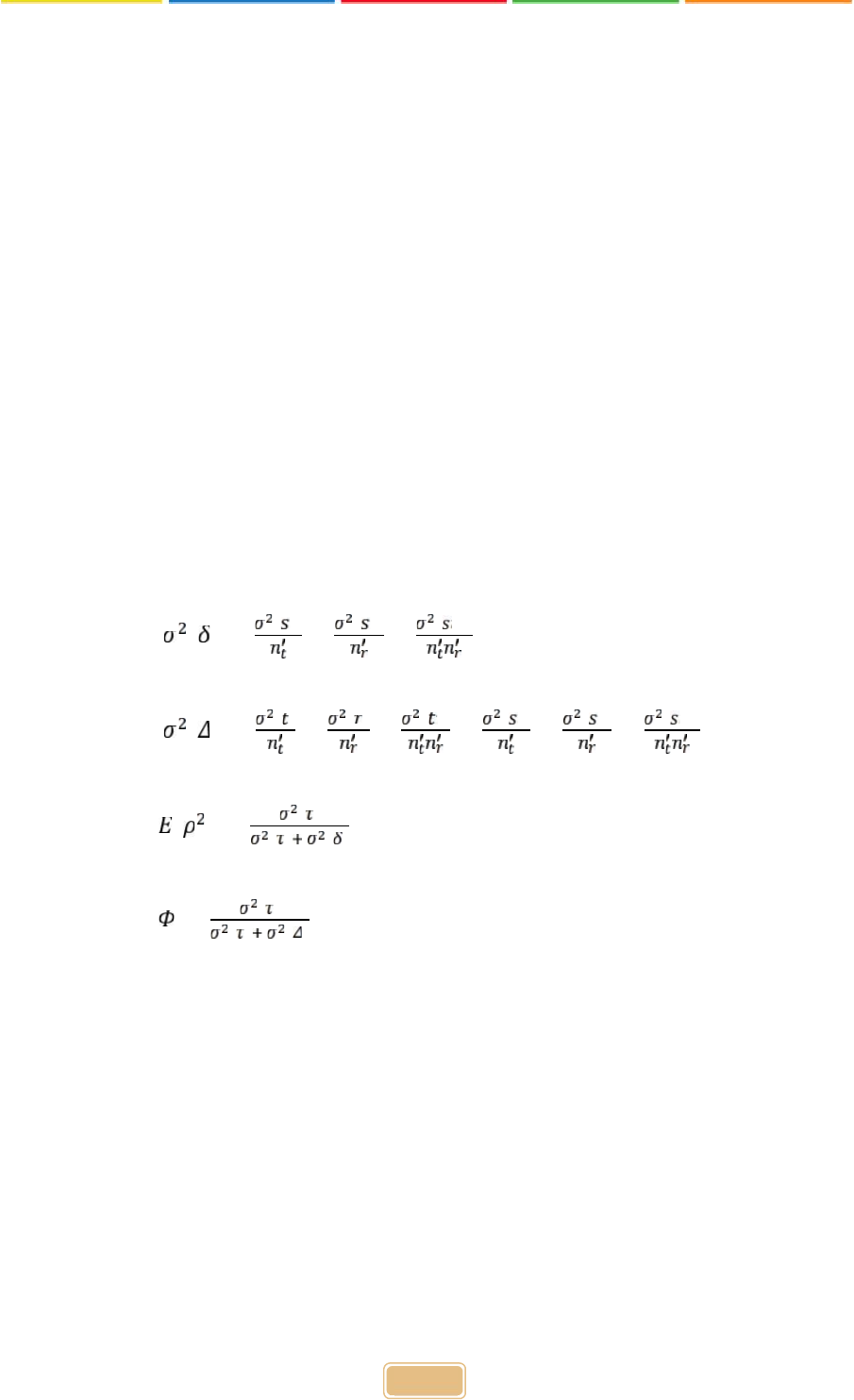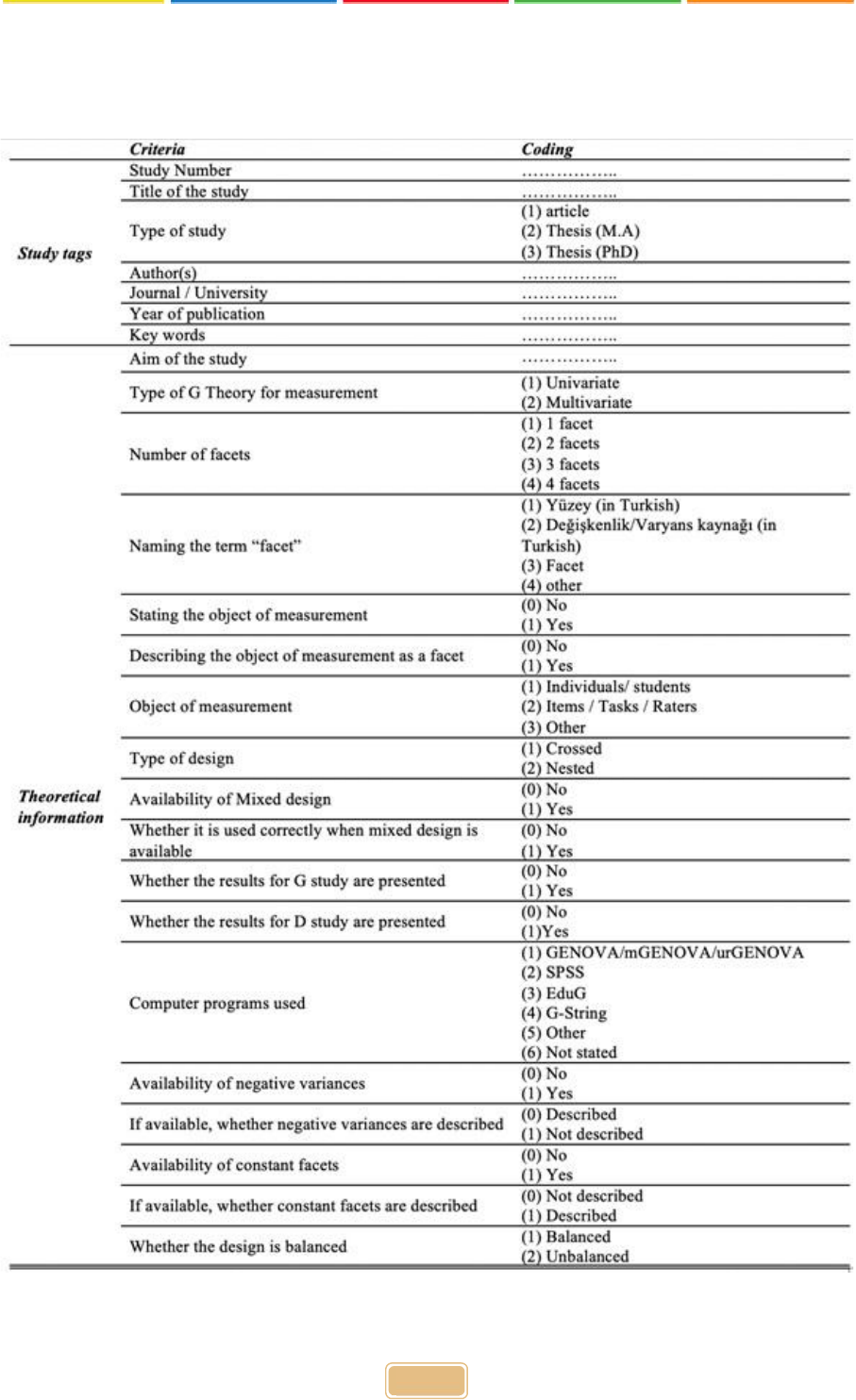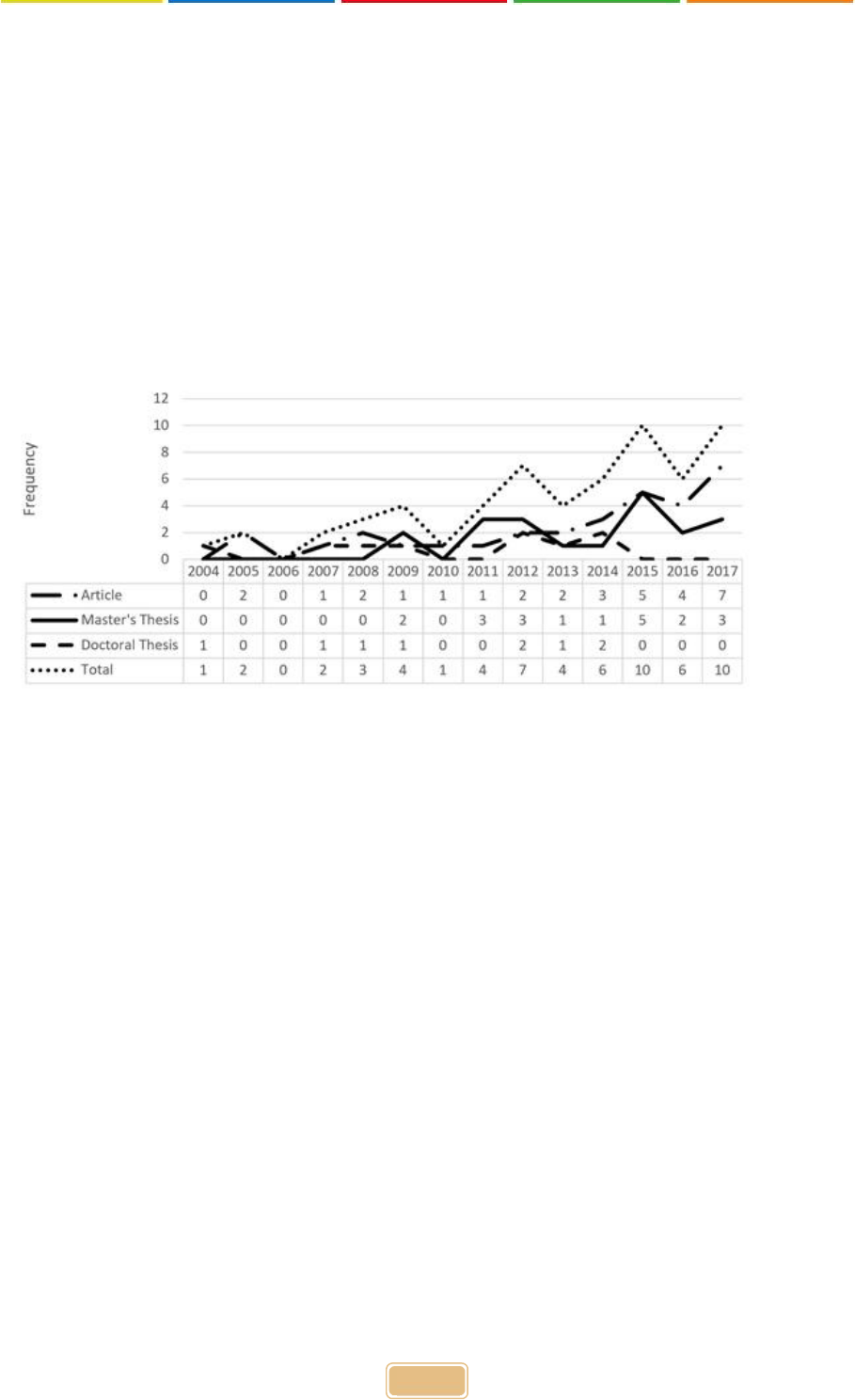
International Journal of Assessment Tools in Education
2019, Vol. 6, No. 2, 279–299
https://dx.doi.org/10.21449/ijate.569996
Published at http://www.ijate.net http://dergipark.org.tr/ijate Research Article
279
Thematic Content Analysis of Studies Using Generalizability Theory
Gülşen Taşdelen Teker
1
*
, Neşe Güler
2
1
Hacettepe University, Faculty of Medicine, Department of Medical Education and Informatics, Ankara, Turkey
2
İzmir Demokrasi University, Faculty of Education, Measurement and Evaluation Department, İzmir, Turkey
ARTICLE HISTORY
Received: 11 March 2019
Revised: 14 May 2019
Accepted: 22 May 2019
KEYWORDS
Educational sciences,
Generalizability theory,
Thematic content analysis
Abstract: One of the important theories in education and psychology is
Generalizability (G) Theory and various properties distinguish it from the
other measurement theories. To better understand methodological trends of
G theory, a thematic content analysis was conducted. This study analyzes
the studies using generalizability theory in the field of education in Turkey
by using the method of thematic content analysis. It reviews 60 studies,
including 31 articles and 29 theses published from 2004 to 2017. The
selected studies underwent thematic content analysis using parameters
including tagged information, aim, G Theory type, number of facets used in
the study, Turkish word for “facet,” object of measurement, sample size,
design type, mixed-design availability, shared results of G and D studies,
computer programs, method of calculating negative variance, availability of
fixed facets, and design balance. The data were interpreted on the basis of
frequencies; both table and figures are included in the study. According to
the results, there is an increase in the number of studies conducted by using
G theory by years. Of these, many compare theories; most of them applying
univariate G Theory and consider two-faceted measurement situations.
While a small subset of studies features mixed design, a large group features
crossed design, with individuals as the object of measurement. The
computer program most commonly used in analyses is EduG. The majority
of studies use balanced design. Recommendations are provided accordingly
with the results.
1. INTRODUCTION
One of the most important steps taken in any scientific study is the measurement process used
to obtain information needed to analyze a particular object or property. However, the data
obtained in this process may contain various types of “error.” These errors, which differ in
accordance with the measurement conditions, have a different meaning from the one that is
traditionally assumed. Errors occur naturally in measurement; it is therefore essential to
determine how and under what conditions to carry out “ideal” acts of measurement, given this
reality. In education and psychology, this issue is discussed as an aspect of “reliability,” which
Medicine, Department of Medical Education and Informatics, Ankara, Turkey
ISSN-e: 2148-7456 /© IJATE 2019

Taşdelen Teker & Güler
280
may be defined as the extent to which the observed scores are consistent (or inconsistent)
(Brennan, 2011).
One of the theories concerning reliability in education and psychology is the Generalizability
(G) Theory. This theory enables a researcher to determine the source and number of
inconsistencies in the observed scores. Another theory, Classical Test Theory (CTT), consists
of observed scores (X), real scores (T), and error scores (E) (X= T + E). Although only one
error term appears in this model for CTT, the term contains all probable errors. In this context,
one of the most important advantages of G Theory is that it enables the investigation of different
sources of error within the model it is based on. For instance, the relation between G Theory
and the process of measurement where there are K number of sources of error can be described
as follows:
X = µ
s
+ E
1
+ E
2
+ ... +E
K
(1)
Here, µ
s
in Equation 1 is the universe score, interpreted in a similar way to the real score in
CTT. The universe score is defined as the expected value of the observed scores obtained
through repetitive measurements (Brennan, 2001). One of the properties that makes G Theory
important and different is its conceptual framework. The concepts in this framework are the
universe of admissible observations, Generalizability (G) study, the universe of generalization,
and decision (D) study. The present study uses a sample situation to ensure that these G Theory
concepts are understood better. For example, consider a measurement process in which the
mathematical problem-solving skills of students are measured in different tasks (t) and scored
by more than one rater (r). This process contains two facets, labelled “tasks” and “raters.” Facets
represent similar situations in measurement. Let us assume that tasks (one facet in this
measurement process) contain an infinite number of tasks, while raters (another facet in this
measurement process) contain an infinite number of raters. Both facets have been selected from
an infinite universe of admissible observations. If each rater scores each task carried out by
every student in the sample process, the measurement design is called a crossed design, and the
process is represented as sxtxr. If, however, each task carried out by all students in the process
is scored by different raters, the raters are said to be “nested” in the tasks and the study design
is known as a “nested design,” represented as sx(r:t). A crossed design is usually preferred in
studies conducted using G Theory. The reason for this is that all sources of error, associated
with all probable facets and the interactions between those facets, can be estimated in crossed-
design studies. This situation gives D studies great flexibility.
A careful analysis of the example above makes clear that students also participate in the process,
alongside tasks and raters; they too are considered variance sources of the measurement process.
Any individuals, students, objects, or situations constituting the subject matter being measured
are called the object of measurement in G Theory. While the term universe is used to denote
the facets of measurement in G Theory, population is preferred for the object of measurement
(Brennan, 1992). Observable scores, obtained by evaluating a task in the population or universe
of admissible observations by a rater, are represented in Equation 2:
X
str
= µ + ʋ
s
+ ʋ
t
+ʋ
r
+ʋ
st
+ʋ
sr
+ʋ
tr
+ʋ
str
(2)
In Equation 2, µ represents the average within the universe and population, while ʋ represents
each of the seven unrelated components. This is a linear model of sxtxr (Brennan, 2011; Güler,
Uyanık, & Teker, 2012). A model of this design contains seven sources of variance, known as,
“G study variance components.” Once these variance components have been estimated, the
values can be used in estimates of universe score variance, error variance, various
generalizability universe coefficients with similar interpretations, and various D-study designs.
Variance components in a G study can be estimated using the expected values of squares
average in the variance analysis. As is clear from here, a variance analysis (ANOVA) appears

Int. J. Asst. Tools in Educ., Vol. 6, No. 2, (2019) pp. 279–299
281
in the statistical structure of Equation 2. However, the F test is not used in G Theory. This case
reflects one of the operational differences that distinguish G Theory from traditional variance
analysis (Brennan, 1992; Güler et al., 2012).
The variance components obtained through the G study are used to design various D studies.
The above-mentioned example can help to explain this situation. Let us assume that there is a
process of measurement in which students’ mathematical problem-solving skills are evaluated
by three raters (r) using five different tasks (t). Each level of the two facets (tasks and raters) is
called a condition. In this study, there are five conditions for the facet of tasks and three
conditions for the facet of raters. Firstly, the variance components are calculated using the data
obtained through the G study. After that, various D studies can be set up to decide on designs
containing the same or different numbers of conditions of the facets made available by the G
study. For instance, in D studies organized on the basis of a G study with five available tasks,
designs can be created in which the same number (5), a smaller number (1, 2, 3 or 4), or a larger
number (6, 7 etc.) of tasks is available; such designs can also include the same or a smaller or
larger number of raters. One point to take careful note of here is that the variance components
obtained through the G study are values estimated using a single task and rater (one condition).
Thus, estimates made for various numbers of facet and task conditions also constitute D studies.
The universe score variance for a randomly crossed D study with the same structure as the G
study in the example above is as follows:
σ
2
(τ) = σ
2
(s) (3)
The relative error variance is:
( )
=
( )
+
( )
+
( )
(4)
The absolute error variance is:
( )
=
( )
+
( )
+
( )
+
( )
+
( )
+
( )
(5)
The generalizability coefficient is:
( )
=
( )
( )
( )
(6)
The dependability coefficient is:
=
( )
( )
( )
(7)
As equations 3, 4, 5, 6 and 7 make it clear, G Theory is based on average score metrics
(Brennan, 2011), unlike CTT, which is based on total score metrics. In addition, the relative
error variance and generalizability coefficient are interpreted in a similar way to the error
variance and dependability coefficient, which are based on a relative comparison of individuals
in CTT. Another point worth noting is that the generalizability coefficient and the dependability
coefficient are not equal in G Theory. The error variance and dependability coefficient, based
on absolute decisions that can be calculated in G Theory, cannot be calculated in CTT.
However, both the absolute error variance and the error variance in CTT are derived from the
random sampling assumption; when more than one facet is taken from the generalizability
universe, the CTT error variance can be estimated at very low levels (for further details, see
Brennan, 1997).
The above equations can also be applied to different generalizability universes and D studies.
For instance, let us suppose that the raters assessing student mathematical problem-solving
skills are constant. In other words, let us suppose that the purpose is not to generalize the raters

Taşdelen Teker & Güler
282
in this study into a larger universe (alternatively, assume that all of the raters in the universe are
the raters in this study). In this case, the universe score variance is:
σ
2
(τ) = σ
2
(s) +
( )
(8)
The relative error variance is:
( )
=
( )
+
( )
(9)
And the absolute error variance is:
( )
=
( )
+
( )
+
( )
+
( )
(10)
It is clear that, when the rater facet is constant, estimated error variances decrease and universe
score variance increases. This means that dependability coefficients will be estimated at high
levels. However, the gain obtained by the increase in dependability values restricts the
interpretations that can be made in relation to generalizability. In a similar way, as the sample
size increases in D studies (that is to say, as the number of conditions increases) and/or when
the study has a nested design, error variance decreases; the increase in the number of nested
facets in the design restricts the interpretations that can be made in relation to the
generalizability of measurements.
G Theory is basically a theory of measurement based on random facets. Therefore, at least one
facet should be taken at random in the measurement process. The measurement models in which
constant (as well as random) facets are available are known as mixed models in G Theory
(Brennan, 1992).
All the above-mentioned examples relate to univariate G Theory. However, some studies are
considered in the context of multivariate G Theory. In the first example above, let us suppose
that the students are expected to deal with algebraic and analytic problems. Universes of
admissible observations correspond to each context and each universe corresponds to one single
constant case. In other words, a univariate mixed model can be formulated with a multivariate
model, which requires a constant facet; a more flexible representation of the constant facet is
thus assured. At a statistical level, multivariate G Theory analyses involve not only variance
components, but also co-variance components (Brennan, 2011). In the case of a simpler
explanation, the univariate G Theory may be used to analyze the scores obtained from a single
test; multivariate G Theory is used to determine the generalizability of scores obtained from a
test composed of different sub-tests (Atılgan, 2004; Brennan, 2001; Deliceoglu, 2009).
Three fundamental theories can be used to determine reliability: CTT, Item Response Theory
(IRT), and G Theory. Of these, CTT is generally preferred because its underlying mathematical
model is easier to understand and its assumptions are flexible (Hambleton & Jones, 1993).
Although IRT contains a more complicated mathematical model and its assumptions are
difficult to meet, it takes precedence over individual measurement applications because it can
generate independent estimates of item and ability parameters. CTT and G Theory focus on test
results, while IRT focuses on responses to items (Brennan, 2011).
Various properties distinguish G Theory from the other two theories. Although the
mathematical structures of the basic equations in CTT and G Theory are similar, with
unobservable values on the right (X = T + E, and equation, respectively), CTT has only one
error term, while G Theory permits the division of error terms to reflect different sources of
error. G Theory also has a richer conceptual framework than CTT. Two points are particularly
relevant: (1) in G Theory, it is possible to distinguish between constant and random facets; (2)
G Theory makes it possible to carry out different types of decision studies (Brennan, 2011).

Int. J. Asst. Tools in Educ., Vol. 6, No. 2, (2019) pp. 279–299
283
Cronbach et al., (1972) and Brennan (2001) argue that G Theory removes the difference
between reliability and validity. One of the most important differences between G Theory and
IRT is that, while G Theory focuses on test scores, IRT focuses on item scores. Although items
are a constant facet in IRT, they are almost always considered random in G Theory (Brennan,
2011).
In recent years, Turkey has seen an increase in studies conducted using G Theory. Researchers
in education and other fields have shown more interest in G Theory because it differs from CTT
and IRT and can be advantageous in a number of situations. Given this context, the present
study uses various criterial to analyze G Theory-based research carried out in Turkey. Its main
purpose is to determine the general tendency of G Theory-based studies and to provide new
resources and information to researchers who may have doubts about using G Theory in their
own research. To enhance the quality of future academic work, examination themes are also
explained in detail. For researchers hoping to contribute to literature on any topic, general trends
in current studies in the relevant field, gaps in the literature, and research characteristics
presented are very important.
The literature included a review of studies on the use of G Theory: Rios, Li, and Faulkner-Bond
(2012), examined 58 studies published in the field of psychology and education between 1997
and 2012, focusing on sample size, the handling of missing data, the question of balance (or
unbalance), multiple group comparisons, analysis trends (e.g., computer programs used,
methods of estimating variance components), and reporting results. Other than this study, no
published research had explored studies conducted using G Theory, indicating a gap in the
literature. The present study sets out to provide detailed information on the theoretical and
conceptual bases of G Theory to guide researchers aiming to conduct research on the
deficiencies of or mistakes made in published studies. The present study makes an important
contribution to the literature by promoting the widespread, correct use of G Theory, which is
now widely and increasingly studied, by introducing this theory to researchers in the main
branches of science, beyond the educational sciences.
The present study therefore examines research carried out using G Theory in the field of
education in Turkey using the thematic content analysis method. The following questions
guided the current study:
1. What were the aims of the research studies analyzed?
2. Which types of G Theory are used more often in measurement situations?
3. How many faceted designs are used in the study?
4. How is the term “facet” translated into Turkish?
5. Did the object of measurement specify?
6. What is the sample sizes used in the studies?
7. What types of designs are covered?
8. What types of mixed design exist and how can they be used correctly?
9. What proportion of studies fall into the G and D studies categories?
10. Which computer programs are used most frequently?
11. What is the preferred way of explaining negative variance when analyzing
research results?
12. What are the various types of fixed facet and how are they discussed?
13. At what rate do studies use balanced or unbalanced patterns?

Taşdelen Teker & Güler
284
2. METHOD
2.1. Research Model
The present study has carried out a thematic content analysis of theses and articles based on G
Theory in the field of education in Turkey in 2004–2017; the various themes covered here were
selected to reveal their similarities and differences. A thematic content analysis involves the
synthesis and interpretation of different research findings on the same subject (Au, 2007, Çalık
& Sözbilir, 2014, Finfgeld, 2003, Walsh & Downe, 2005). Studies that conduct a thematic
content analysis provide a very rich resource to researchers working in related fields, who
cannot access all the work in the field or systematically examine those studies (Çalık, Ayas, &
Ebenezer, 2005; Ültay & Çalık, 2012). Compared to meta-analyses and descriptive content
analysis studies, relatively few studies offer thematic content analyses (Çalık & Sözbilir, 2014).
2.2. Data Collection
All of the education articles incorporating G Theory published in Turkey between 2004 and
2017 were obtained using the Google Academic search engine and/or which were reached in
journals indexed by ULAKBIM (national index) and Social Science Citation Index (SSCI). All
of the theses in the Council of Higher Education’s National Thesis Centre Database of Turkey
were also included in the scope of this study. There are no studies carried out in Turkey used G
Theory before 2004. For this reason, the starting point for this study was set as 2004. There
were 41 articles from 23 different journals and 29 theses published in six different universities.
Ten of the articles analyzed were derived from Master’s or Ph.D. theses; they were compared
with the original M.A. or Ph.D. theses and found to be no different. The reason for excluding
articles derived from Master’s or doctoral theses was to avoid duplicating studies. Excluding
them made it possible to present a more accurate picture of G Theory studies. The elimination
of such studies left a total of 60 studies, 31 articles, 20 Master’s theses, and 9 Ph.D. theses for
content analysis. The investigated studies are listed in Appendix.
2.3. Data Analysis
Before carrying out the content analysis, the researchers developed a checklist to help them
analyze studies incorporating G Theory. The purpose of the checklist was to set standard criteria
for analyzing the articles. The checklist had two main parts: “study tag” and “theoretical
information.” Expert opinions were obtained from three measurement and evaluation
specialists, who had carried out studies on G Theory and were able to evaluate the checklist.
The specialists recommended including key words and author names in the tags used to describe
studies under analysis. The checklist was updated to reflect these views; the version shown in
Figure 1 was ultimately used by two researchers in this study.
To ensure consistency across different researchers, five randomly selected studies were
examined independently by two researchers. Using the data obtained, Equation 11 (suggested
by Miles and Huberman (1994)) was used to calculate consistency between researchers, as
follows:
Reliability = = .86 (11)
The interrater consistency obtained using Equation 11 was calculated as .86. This value should
be .80 or above (Miles & Huberman, 1994, Patton, 2002). This result compared to the criterion
drawn from the literature, sufficient coherence is obtained. Within the scope of this study, 60
studies were reviewed by researchers, in accordance with the themes in Figure 1, to identify
any inconsistencies in the data. Articles or theses with inconsistencies were reviewed by the
researchers again independently, to see whether there was any disagreement. For just one study
researchers had a disagreement. The researchers came together to discuss the issue and tried to

Int. J. Asst. Tools in Educ., Vol. 6, No. 2, (2019) pp. 279–299
285
reach agreement, as well as obtaining the opinion of a third independent researcher. As a result
of this process, once consent of researchers has been obtained, all the data were combined.
Frequency and percentage analyses of codes were carried out for each theme.
Figure 1. Checklist used in the study

Taşdelen Teker & Güler
286
3. RESULT / FINDINGS
The research findings are presented in two parts. The first section headings refer to the tags
used to categorize the articles and theses; the second section focuses on theoretical information.
3.1. Findings Related to Tagged Information in the Studies Analyzed
3.1.1. Year of publication
Figure 2 shows the distribution of articles and theses by publication year. Although the increase
has not been steady, there has clearly been an increase in the number of articles and theses
written using G Theory since 2004. While the increase in the number of articles has reached a
peak in recent years, the number of Master’s theses reached its highest value in 2015; although
G Theory continues to be used regularly, frequency has decreased in the last few years. Among
doctoral theses, there was an increase between 2012 and 2014; after that date, there is no
doctoral thesis conducted on G Theory.
Figure 2. Distribution of articles and theses by year
As is clear from Figure 2, the first Turkish doctoral thesis to use G Theory was completed in
2004. It was followed by one doctoral thesis per year in 2007, 2008, 2009, and 2013, and two
doctoral theses in 2012 and in 2014. The first Master’s thesis was written in 2009 (f=2). While
no Master’s theses used G Theory in 2010, it was used in 1–5 theses every year after 2011.
3.1.2. Keywords
The keywords in the 31 articles and 29 theses were reviewed to determine their frequencies.
109 different key words were used in the studies. The most frequently used word was
Generalizability Theory (f=56) – as expected. Reliability (f=23), Classical Test Theory (f=13),
interrater reliability (f=8) and decision study (f=8) were the most frequently used key words.
These were followed by generalizability coefficient (f=6), generalizability (G) study (f=5) and
Phi coefficient (f=5), as the basic concepts in G Theory. In addition, 75 key words were used
just one time each. “Rating/rater/scoring” concepts were included among the 39 key words; of
these concepts, “scoring key/rubric” appears in 12 of them. Computer programs used in G
Theory analysis, including EduG, GENOVA, mGENOVA, SAS, and SPSS were used 13 times.
3.2. Findings Involving Theoretical Information
Aim of the study: G Theory can be used in a range of different academic fields. According to
the topics, theory comparison was the most commonly studied subject throughout the studies.
14 studies compared G Theory to CTT and Many-Facet Rasch Model (MFRM). In addition, six
studies compared performance assessment tools (checklists and analytical and holistic rubrics).
In nine studies set out to establish the most appropriate number of raters, the quality of raters
involved in evaluation, and interrater reliability. They examined the reliability of scores

Int. J. Asst. Tools in Educ., Vol. 6, No. 2, (2019) pp. 279–299
287
obtained from measurement tools including the Vee diagram, concept map, multiple-choice
tests, structured grids, and performance tasks (f=10). Other studies investigated instructor, peer,
and self-evaluation results; standard setting methods; computer software used in analyses
(SPSS, GENOVA, EduG, and SAS), and the results obtained from the crossed and nested
designs. Various reliability methods were also compared.
Type of G Theory used for measurement: Generalizability Theory can be univariate or
multivariate, depending on the measurement situation involved. Most of the studies examined
(f=54) included univariate G Theory analyses. Because of its complexity, multivariate G
Theory was used in just three Ph.D. theses and three articles written by the same authors.
The number of facets used in the study: Measurement situations with two facets appeared in
45 studies; nine studies included measurement situations in which one and two facets were
considered together. It has been observed that one facet in three studies, three facets in two
studies, and four facets in one study.
Translating the term “Facet”: Since the term was translated into Turkish in different ways in
G Theory studies in Turkey, the naming of this concept was also considered. It was most
frequently used as “the source of variability (değişkenlik kaynağı)” in the studies analyzed in
this study (f= 18). It was used as “surface (yüzey)” in seven studies, as “the source of variance
(varyans kaynağı)” and “variable (değişken)” in four studies, and “component (bileşen)” and
“variance component (varyans bileşeni)” in one study each. It was called “facet” in one study
written in Turkish without finding Turkish concept for it. Only one of the 13 works written in
English used "variance source" instead of "facet". In 11 studies, however, it was observed that
the term was not considered although the G Theory was used.
Presenting and describing the object of measurement as a facet: Only two studies considered
the object of measurement as a facet. While 44 studies clearly defined the object of
measurement, 14 gave no explanation. When observations related to the state of the
measurement object, only 25 studies clearly defined the object of measurement. Of the
remaining 35 studies, 23 provided no information and 10 provided the correct usage. Two
studies failed to mention the measurement object and used the concept in the wrong way.
Sample size: Table 1 shows the sample sizes used in these studies.
Of the studies investigated, 16 had sample sizes below 30, while 25 had sample sizes between
30 and 100. Only 19 studies had samples larger than 100.
Table 1. Object of Measurement Sample Size
Object of measurement
Sample size
Frequency
Total
Person
<30
11
55
30–100
25
102–187
10
203–249
5
309
1
689
1
1000
1
1500
1
Item
16
1
3
18
1
20
1
Occasion
7
1
1
Task
6
1
1

Taşdelen Teker & Güler
288
Type of design: The most frequently used design was a crossed design (f=48). Nested designs
were used in seven studies, while five studies used both crossed and nested designs.
The availability and correct use of mixed designs: Only six of the 60 studies used mixed
designs. One study that claimed to have a mixed design actually had a random design.
The presentation of G and D study results: G study results were presented as expected in most
studies except one. In addition, D study results were not given in only three studies. It was
observed that the D study was not performed because the purpose of these studies was not to
estimate the reliability for different measurement situations.
Computer programs used: An evaluation of the computer programs used in the analyses,
revealed that the most frequently used program was EduG (f=32). The second most frequently
used program was SPSS (f=16). GENOVA was used in nine studies, mGENOVA in five
studies, and G-String, R, and SAS were used in two studies each. In five studies, the computer
program was not specified. Since some studies used more than one program (e.g., SPSS-EduG
and SPSS-GENOVA), the sum of the frequency values above exceeds the number of studies
examined.
The availability and description of negative variance: In 21 studies, a negative variance was
observed. Adopting the approach of Cronbach et al., the negative variance was treated as zero
in 11 studies; zero was also used to estimate other variance components. In 10 studies, adopting
Brennan’s approach, the negative variance was regarded as zero and used as it was in estimates
of other variance components.
The availability and description of fixed facets: Six of the studies analyzed had constant facets.
Only two explained these constant designs to readers.
Design balance: Only six of the 60 Turkish studies had an unbalanced design. Of these, two
were Ph.D. theses and one was an article written by one of the Ph.D. authors.
4. DISCUSSION, CONCLUSION and SUGGESTIONS
The present study analyzed 60 Turkish studies in two stages, using tag information and their
theoretical foundations. An examination of the years in which G Theory studies were published
revealed an overall increase in publications, despite occasional decreases. The theoretical
structure of G Theory is complex and difficult to analyze at elementary levels; for this reason,
it is used primarily in doctoral theses. However, beginning with the year 2009, it has also
appeared in Master’s theses. One of the reason for this may be that G Theory Master’s level
analyses are now being conducted by means of user-friendly computer programs, such as EduG,
rather than the more advanced GENOVA. Another reason may be the increasing number of
workshops are held at congresses and courses are taught in Master's and doctoral programs.
User friendly computer programs will make it possible to carry out more analyses based on G
theory for various studies. Another explanation for this result is the increase in the number of
researchers working in the area of measurement and evaluation. In particular, applications for
research-assistant posts in the field of measurement and evaluation have been increased since
2002, resulting in a larger number of researchers working in the field and therefore more studies
based on G Theory.
The keywords presented in the study tags were also analyzed, revealing that G Theory was used
most often in studies involving interrater dependability and standard settings. The fact that 88
words appeared only once or twice appears to show that a range of studies on diverse topics
have been carried out using G Theory. Among studies that feature rating and rater keywords (f
= 39), G Theory is frequently discussed in relation to rater reliability, consistency, the rater
effect, the number of raters, the reliability of ratings, and rating methods. Although CTT is used

Int. J. Asst. Tools in Educ., Vol. 6, No. 2, (2019) pp. 279–299
289
more frequently than G Theory in the literature, it cannot be used to determine the number of
raters needed to obtain more reliable results or the number of criteria to include in scoring keys.
The information available to G Theory through D studies may make it a better choice than CTT,
especially in such studies.
An investigation of the aims of the studies in question found that they made a great number of
theoretical comparisons. By comparison, the most frequently used theory is CTT, which has
been used for many years in the literature and is better known than G Theory in the theoretical
literature. Another theory often used in theory comparisons is MFRM. It is thought that this
model, which is covered in IRT, tends to be preferred because it allows analyses to be carried
out using fewer parameters than other IRT models. Like G theory, MFRM is frequently used to
determine the reliability of a rater; it can consider more than one error source at the same time.
These can also be cited as reasons for comparing G Theory to MFRM. As well as being used
in theory comparisons, G Theory was also preferred when researchers wished to determine the
reliability of scores obtained using various measurement tools. G Theory has the advantage of
being able to simultaneously handle many sources of error in a measurement process at the
same time. While this topic is not new in the literature, many studies have investigated the
reliability of self and peer assessments, which have been discussed more frequently in recent
years. G Theory makes it possible to evaluate the rater as a facet, while also evaluating the
points of self, peers, and instructors as conditions of this facet. Since G Theory makes it possible
to estimate the magnitude of the variance between evaluations of different raters and the
reliability coefficient, it may be preferred in such studies. A final category of studies compared
the results obtained using different types of computer software able to carry out G Theory
analyses. Because of free and user-friendly software and their manuals, the use of G theory
potentially increases.
Most of the studies analyzed in the course of this research were produced using univariate G
Theory. Only five studies used multivariate G Theory, potentially reflecting the following two
factors: (1) the situations considered by researchers were better suited to the use of univariate
G Theory, and (2) researchers preferred not to use multivariate G Theory because it was
relatively difficult and complicated to analyze.
It was found that the most of the studies investigated used two-faceted measurement designs.
Frequency measurement situations with two surfaces may reflect standard educational practice
(items and raters as facets). Very few of these studies had three- or four-faceted designs. As the
number of facets increases in G Theory, the number of estimated variance values for each facet
and the interactions between facets increase. Interactions are therefore difficult to interpret. For
example, where a two-faceted crossed design consists of seven components of variance, in a
three-faceted design, this number increases to 14. Researchers tend to avoid highly faceted
designs because it is difficult to interpret the large number of variance components that result
from the increased number of facets.
The concept of “source of variability” was used in almost half of the studies analyzed instead
of the English term “facet” available in the G Theory. The use of agreed on words can be
supported by reaching an agreement on Turkish equivalents to the English terms and compiling
them in a glossary, and thus comprehensibility of the G Theory studies can be increased. Indeed,
there is such a glossary study conducted in Turkey by the Association of Measurement and
Evaluation in Education and Psychology, and accordingly, it is recommended that the words
“yüzey (facet)” or “değişkenlik kaynağı (source of variability)” be used as corresponding to
English word “facet”. Yet, it was observed that using “source of variability” as Turkish
equivalence to the English word “facet” could cause confusions in studies conducted in Turkish.
The sentence “A one-facet design has four sources of variability” from an important resource
book, “Generalizability Theory: A Primer” by Shavelson and Webb (1991, p.4) would

Taşdelen Teker & Güler
290
exemplify our claim because the translation of the sentence into Turkish would also cause
confusion. Considering this situation, it is thought by researchers that using “yüzey” rather
than “değişkenlik kaynağı” in Turkish as equivalence to English “facet” would be more
appropriate.
In G Theory, the objects to be measured such as students, individuals, methods etc. and
decisions will be made on it known as the object of measurement. Differences in the object of
measurement are defined as “the sources of error” in CTT, since variance that depends on the
object of measurement is a desired situation. These differences are not considered to be facets
in G Theory either. Two of the studies examined presented this idea inaccurately. First, the
difference between the concepts of facet and object of measurement is difficult to understand.
Second, the fact that “facet” is used to express the source of variability in the metric target state,
a distinction that does not exist in MFRM (a theory that G Theory is often compared to) may
add to this confusion. Researchers should therefore be encouraged to clarify which sources of
variability discussed in their studies are facets or objects of measurement. In 54 of the 60 studies
examined, the object of measurement was the individual. Items, tasks, situations, and raters can
all be objects of measurement, depending on the type of measurement. It is very important for
researchers to clearly define the object of measurement and to accurately define it as a measured
object to ensure an accurate interpretation of the findings.
Sample size is quite important in most statistical methods, as it influences the accuracy of
estimates and can increase or reduce errors. Of the studies examined here, 44 had a sample size
of 30 or more. This ratio was considerably higher than the value obtained when Rios, Li and
Faulkner-Bond (2012) conducted 58 studies using G Theory between 1997 and 2012. They
found that the mod of the sample size was 20. Atılgan (2013) examined the effect of sample
size on the G and Phi coefficients and found that it was impossible to make stable predictions
if the sample size was 30 or below. Results could be considered sufficiently unbiased if the
sample size was 50, 100, 200, or 300. With a sample size of 400, the result can be considered
definite. In the context of educational sciences studies undertaken using G Theory in Turkey,
the majority of results are based on an adequate sample size. However, the samples are small
in some of these studies. Due to logistical, economic, and time constraints related to data
collection, some studies based on G Theory have been carried out using smaller samples (Rios,
Li, & Faulkner-Bond, 2012). At this point, a balance must be established between the need to
increase sample sizes to achieve a correct estimate of variance components and the pressures
of staff, time, and cost limitations. While a G Theory sample consisting of 20 individuals is
considered the lower limit (Webb, Rowley, & Shavelson, 1988), more accurate estimates can
be obtained from larger samples. In future studies, it may be advisable to use the largest sample
size possible. In particular, researchers struggling with unbalanced, complex designs may end
up deleting data and changing to a balanced format. Such situations reduce the size of study
samples. In recent years, it has become possible to overcome these difficulties via user-friendly
software, capable of carrying out unbalanced pattern analyses.
Many studies in the literature have been conducted using G Theory; the majority of studies
examined here (f = 47) have adopted a crossed design, possibly because all possible sources of
variance can be estimated in fully crossed designs. Only in fully crossed designs can researchers
access the variance values of each source of variability, as well as their interactions. In nested
designs, it is not possible to estimate the variances of nested facets alone. For this reason,
crossed designs may be preferred to nested designs. In the studies investigated here, the nested
facet in nested designs was generally raters. Particularly in a performance assessment, it may
not be possible for each individual to be evaluated by all of the raters. Such measurement
situations should be monitored in relation to variables including cost and the effective use of

Int. J. Asst. Tools in Educ., Vol. 6, No. 2, (2019) pp. 279–299
291
the resources. If it is not possible to use a crossed design, the study should be carried out using
nested designs.
G Theory is basically a theory of measurement with random facets; for this reason, at least one
facet should be random (Güler et al., 2012). If at least one facet in a design is constant and the
other facets are random, the design is said to be mixed. The present investigation of studies
conducted using G Theory in Turkey found that only six of the 60 studies examined used the
term "mixed design". In only one of these six studies, the mixed design was defined as "the
combined use of crossed and nested facets". On the other hand, in basic sources of G theory in
the literature mixed models are defined as the the measurement models in which constant (as
well as random) facets are available are known as mixed models in G Theory (Brennan, 1992;
Shavelson & Webb, 1991), and the other five studies used the mixed model in accordance with
this definition. Actually, those five studies used multivariate G Theory. While multivariate G
Theory is used to generalize scores obtained from a test containing different sub-tests, the sub-
tests are regarded as constant facets (Brennan, 2001). For this reason, multivariate G Theory
studies are essentially mixed design studies. Although one study analyzed here had a random
design, it was presented as mixed, possibly because the crossing and nesting of facets in the
same design was wrongly perceived as indicating a mixed design. In describing a design as
mixed, it is important not to use crossed and nested designs together; at least one of the facets
must be fixed. Taking this into consideration will enable the terminology of G Theory to be
used more accurately.
In G Theory, it is possible to investigate dependability in two stages, via a Generalizability (G)
study and a Decision (D) study (Brennan, 2001; Goodwin, 2001; Shavelson & Webb, 1991).
Except in one of the studies examined, G study results were shared. It is appropriate to share
the results of analyses obtained to serve the purpose of a study. If the variance components
estimated as a result of the G study are not evaluated, it may be sufficient to share only the
predicted G and Phi coefficients. The present study also considered the D studies carried out
within G Theory by 56 of the studies examined. In education, researchers frequently investigate
ways to reduce error and improve the reliability of measurements designed for particular
purposes. The fact that most of the examined studies carried out D studies, which serve this
purpose within the framework of G Theory, may reflect a general effort to increase credibility.
An evaluation of computer programs revealed that a majority of studies used EduG. This may
reflect the fact that EduG is free and relatively user-friendly. The common use of G Theory
depends not only on the need for available reference materials that clearly and comprehensibly
explain its theoretical foundations, but also on the availability of user-friendly computer
programs to perform analyses. The first computer program developed to carry out G Theory
analyses was GENOVA, developed by Brennan in 1983. Brennan wrote a detailed explanation
of both univariate and multivariate G Theory in “Generalizability Theory,” released in 2001;
the author developed mGENOVA for multivariate analyses, and urGENOVA to estimate
balanced and unbalanced designs and random effect variance components. The syntax in which
G Theory analyses could be performed on the SPSS, SAS, and MATLAB programs was
released in 2006. The fact that this syntax has been organized for use with relatively common
programs is a positive step toward expanding the use of G Theory. In 2006, Jean Cardinet
released EduG Program. Finally, in 2011, the G-String Program—which can also be used for
unbalanced designs—was produced by Bloch and Norman. In addition to these software tools,
it is possible to carry out a G Theory analysis via the “gtheory” package using R, which is a
free software. It is possible to see the impact of software by examining the yearly distribution
of G Theory studies (see Figure 2). Improved software compatible with G Theory analyses and
the publication of user guides will increase its use among researchers from various disciplines.
In this context, computer programs are clearly important.

Taşdelen Teker & Güler
292
As the literature indicates, variance estimates can sometimes be negative. Negative estimates
are caused by erroneous measurement models or sampling errors (Güler et al., 2012). Since a
negative variance indicates the wrong choice of models or samples, precautions should be taken
in cases where the variance is negative. Cronbach et al., (1972) initially said that the negative
variance should be replaced with zero and that zero should be used to calculate other variance
components. Brennan (1983, 2001), however, argued that this suggestion could cause biased
calculations of variance components. Cronbach responded by saying that, although the negative
variance should be replaced by zero, the negative value itself should be used to calculate other
variance components (Atılgan, 2004). When the variance is negative, the value is either
replaced by zero or used as it is. The decision-makers are not researchers, but computer
programs. None of the analyzed studies explained this situation. Depending on the software
that are used, researchers can access the analysis results or carry out estimates using both
approaches.
Another point of importance in G Theory is whether or not the design is balanced. In a balanced
design, the number of observations is equal at every level of the source of variability. However,
observations per variable are not equal in an unbalanced design, due to lost data or differences
between the number of observations and the levels of variables (Brennan, 2001). Let us
consider, for instance, a measurement situation in which individuals respond to two different
testlets, and in which the items are nested within the testlets and the individuals are crossed
with them. If the testlets have an equal number of items, the design is balanced. If each testlet
has a different number of items, then the design is unbalanced. In other words, if there are three
items in each testlet, the design is balanced—but if there are two items in one testlet and four
in the other, the design is unbalanced. The fact that unbalanced designs have been used in
studies based on G Theory in recent years indicates that researchers are considering using the
theory in different measurement situations. The very small number of studies using unbalanced
designs (f=3) may reflect the fact that designs involving unbalanced data are relatively complex.
Another explanation may be that the researchers have removed some data or filled in the
missing data to change their unbalanced designs into balanced ones. One final explanation may
be that, previously, G Theory analyses of unbalanced data could only be carried out using the
urGENOVA program—which was very complex and avoided by researchers. The G String
program produced in 2011 by Bloch and Norman (used in three unbalanced-design studies) is
an easy-to-use and useful program. This program may become widespread and commonly used
with the researches conducted with unbalanced datasets.
Since the study has offered both detailed conceptual and theoretical explanations, as well as
information on general biases, it can serve as a resource for prospective researchers. One
limitation of the present research is the fact that it focused on studies in the field of educational
sciences. Despite this, it provides information that could be of substantial value to the
researchers in other fields, helping to promote the widespread and accurate use of G Theory in
many other scientific fields.
Initiatives designed to increase the use of G Theory, such as organizing seminars and
workshops, supervising post-graduate theses, and writing books and articles to inform
researchers, will raise awareness among scientists, encourage them to use G Theory and
increase its use. G Theory can also be introduced to all departments in educational faculties and
medical schools. Many departments within faculties of education, health sciences (a field in
which G Theory studies are relatively common), and educational sciences fields that carry out
measurement and evaluation research will also benefit from using G Theory. Since there can
be multi faceted measurement designs in the above mentioned fields, carrying out the researches
by using G Theory can improve the qualifications of those studies. For instance, there are
studies related to special education (Pekin, Çetin, & Güler, 2018), science education

Int. J. Asst. Tools in Educ., Vol. 6, No. 2, (2019) pp. 279–299
293
(Shavelson, Baxter, & Pine, 2009; Yin & Shavelson, 2008), mathematics education (Kersting,
2008; Lane, Liu, Ankenmann, & Stone, 1996), medical education (Lafave & Butterwick, 2014;
Turner, Lozano-Nieto, & Bouffard, 2006) and dentistry education (Taşdelen Teker & Odabaşı,
2019; Gadbury-Amyot et al., 2014).
ORCID
Gülşen Taşdelen Teker https://orcid.org/0000-0003-3434-4373
Neşe Güler https://orcid.org/0000-0002-2836-3132
5. REFERENCES
Arık, R. S. & Türkmen, M. (2009). Examination of the articles in the scientific journals
published in the field of educational sciences. Paper presented at I. International Congress
of Educational Research, Çanakkale, Turkey.
Atılgan, H. (2004). Genellenebilirlik kuramı ve çok değişkenlik kaynaklı Rasch modelinin
karşılaştırılmasına ilişkin bir araştırma [A research on the comparison of the
generalizability theory and many facet Rasch model] (Doctoral Dissertation). Hacettepe
University, Ankara.
Atılgan, H. (2013). Sample size estimation of G and Phi coefficients in generalizability theory.
Eurasian Journal of Educational Research, 51, 215–228.
Au, W. (2007). High-stakes testing and curricular control: A qualitative metasynthesis.
Educational Researcher, 36, 258–267.
Bektaş, M., Dündar, H. & Ceylan, A. (2013). Investigation of several variables papers national
classroom teacher education symposium. Uşak University Journal of Social Sciences,
6(2), 201–226. DOI: http://dx.doi.org/10.12780/UUSBD167
Bloch, R. & Norman, G. (2011). G String 4 user manual (Version 6.1.1). Hamilton, Ontario,
Canada. Retrieved from http://fhsperd.mcmaster.ca/g_string/download/g_string_4_man
ual_ 611.pdf
Brennan, R. L. (2011). Generalizability Theory and Classical Test Theory. Applied
Measurement in Education, 24, 1–21. doi:10.1080/08957347.532417.
Brennan, R. L. (2001). Generalizability Theory. New York: Springer-Verlag.
Brennan, R. L. (1997). A perspective on the history of Generalizability Theory. Educational
Measurement: Issues and Practice, 16(4), 14–20. https://doi.org/10.1111/j.1745-
3992.1997.tb00604.x
Brennan, R. L. (1992). Elements of Generalizability Theory. NY: Springer-Verlag.
Çalık, M. & Sözbilir, M. (2014). Parameters of content analysis. Education and Science,
39(174), 33–38. doi:10.15390/EB.2014.3412
Çiltaş, A. (2012). Content analysis of the graduate thesis and dissertations in mathematics
education in Turkey between 2005-2010. The Journal of Academic Social Science
Studies, 5(7), 211–228.
Çiltaş, A., Güler, G. & Sözbilir, M. (2012). Mathematics education research in Turkey: A
content analysis study. Educational Sciences: Theory & Practice, 12(1), 565–580.
Deliceoğlu, G. (2009). The Comparison of the reliabilities of the soccer abilities’rating scale
based on the Classical Test Theory and Generalizability. (Doctoral Dissertation). Ankara
University, Ankara.
Doğru, M., Gençosman, T., Ataalkın, A. N. & Şeker, F. (2012). Fen bilimleri eğitiminde
çalışılan yüksek lisans ve doktora tezlerinin analizi [Analysis of master's and doctoral
theses in science education]. Journal of Turkish Science Education, 9(1), 49–64.
Finfgeld, D. L. (2003). Metasynthesis: The state of the art-so far. Qualitative Health Research,
13(7), 893–904. DOI: 10.1177/1049732303253462

Taşdelen Teker & Güler
294
Gadbury-Amyot, C. C., Kim, J., Palm, R. L., Mills, G. E., Noble, E. & Overman, P. R. (2003).
Validity and reliability of portfolio assessment of competency in a baccalaureate dental
hygiene program. Journal of Dental Education, 67(9), 991-1002.
Göktaş, Y., Küçük, S., Aydemir, M., Telli, E., Arpacık, Ö., Yıldırım, G. & Reisoğlu, İ. (2012).
Educational technology research trends in Turkey: A content analysis of the 2000–2009
decade. Educational Sciences: Theory & Practice, 12(1), 191–196.
Gülbahar, Y. & Alper, A. (2009). Trends and issues in educational technologies: A review of
recent research in TOJET. The Turkish Online Journal of Educational Technology –
TOJET, 8(2), 124-135.
Güler, N., Kaya Uyanık, G. & Taşdelen Teker, G. (2012). Genellenebilirlik Kuramı
[Generalizability Theory]. Ankara: PegemA Yayıncılık.
Güler, N. (2008). A research on classical test theory, generalizability theory and Rasch model
(Doctoral Dissertation). Hacettepe University, Ankara.
Günay, R. & Aydın, H. (2015). Inclinations in studies into multicultural education in Turkey:
A content analysis study. Education and Science, 40(178), 1–22. DOI:
http://dx.doi.org/10.15390/EB.2015.3294
Hambleton, R. K. & Jones, R. W. (1993). Comparison of classical test theory and item response
theory and their applications to test development. Educational Measurement: Issues and
Practice, 12(3), 3847. http://dx.doi.org/10.1111/j.1745-3992.1993.tb00543.x
Kaleli Yılmaz, G. (2015). Analysis of technological pedagogical content knowledge studies in
Turkey: A meta-synthesis study. Education and Science, 40(178), 103–122. DOI:
http://dx.doi.org/10.15390/EB.2015.4087
Karadağ, E. (2009). Eğitim bilimleri alanında yapılmış doktora tezlerinin incelenmesi [A
Thematic Analysis on Doctoral Dissertations Made In the Area of Education Sciences],.
Ahi Evran Üniversitesi Eğitim Fakültesi Dergisi 10(3), 75–87.
Kersting, N. (2008). Using Video Clips of Mathematics Classroom Instruction as Item Prompts
to Measure Teachers’ Knowledge of Teaching Mathematics. Educational and
Psychological Measurement, 68(5), 845-861. DOI:10.1177/0013164407313369
Kılıç Çakmak, E., Çebi, A., Mihçi, P., Günbatar, M. S. & Akçayir, M. (2013). A content
analysis of educational technology research in 2011. 4th International Conference on
New Horizons in Education. INTE 2013 Proceedings Book, 397–409.
Lafave, M. R. & Butterwick, D. J. (2014). A generalizability theory study of athletic taping
using the Technical Skill Assessment Instrument. Journal of Athletic Training, 49(3),
368-372. doi: 10.4085/1062-6050-49.2.22
Lane, S., Liu, M., Ankenmann, R. D. & Stone, C. A. (1996). Generalizability and Validity of a
Mathematics Performance Assessment. Journal of Educational Measurement, 33(1), 71-
92. https://doi.org/10.1111/j.1745-3984.1996.tb00480.x
Miles, M, B., & Huberman, A. M. (1994). Qualitative data analysis: An expanded Sourcebook.
(2nd ed). Thousand Oaks, CA: Sage.
Patton, M.Q. (2002). Qualitative research and evaluation methods (3rd Ed.). London: Sage
Publications, Inc.
Pekin Z., Çetin S. & Güler N. (2018). Comparison of Interrater Reliability Based on Different
Theories for Autism Social Skills Profile. Journal of Measurement and Evaluation in
Education and Psychology, 9(2), 202-215. https://doi.org/10.21031/epod.388590
Rios, J.A., Li, X., & Faulkner-Bond, M. (2012, October). A review of methodological trends in
generalizability theory. Paper presented at the annual conference of the Northeastern
Educational Research Association, Rocky Hill, CT.
Saban, A. (2009). Content analysis of Turkish studies about the multiple intelligences theory.
Educational Sciences: Theory & Practice, 9(2), 833–876.

Int. J. Asst. Tools in Educ., Vol. 6, No. 2, (2019) pp. 279–299
295
Shavelson, R. J. & Webb, N. M. (1991). Generalizability Theory: A primer. Newbury Park,
CA: Sage.
Shavelson, R. J., Baxter, G. P. & Pine, J. (1991). Performance Assessment in Science. Applied
Measurement in Education, 4(4), 347-362. DOI: 10.1207/s15324818ame0404_7
Taşdelen Teker, G. & Odabaşı, O. (2018). Reliability of scores obtained from standardized
patient and instructor assessments. European Journal of Dental Education, 23, 88-94.
DOI: 10.1111/eje.12406
Turner, A. A., Lozano-Nieto, A. & Bouffard, M. (2006). Generalizability of extracellular-to-
intracellular fluid ratio using bio-impedance spectroscopy. Physiological Measurement,
27(4), 385-397. DOI: 10.1088/0967-3334/27/4/005
Yalçın, S., Yavuz, H. Ç. & İlgün Dibek, M. (2015). Content analysis of papers published in
educational journals with high ımpact factors. Education and Science, 40 (182), 1–28.
DOI:10.15390/EB.2015.4868
Yin, Y. & Shavelson, R. J. (2008). Application of Generalizability Theory to Concept Map
Assessment Research. Applied Measurement in Education, 21(3), 273-291. DOI:
10.1080/08957340802161840
Walsh, D. & Downe, S. (2005). Meta-synthesis method for qualitative research: A literature
review. Journal of Advanced Nursing, 50(2), 204–211.
Webb, N. M., Rowley, G. L., & Shavelson, R. J. (1988). Using Generalizability Theory in
counseling and development. Measurement and Evaluation in Counseling and
Development, 21, 81–90.

Taşdelen Teker & Güler
296
6. APPENDIX: List of studies included in research
Atılgan, H. (2004). A Reseach on comparisons of Generalizability Theory and many facets
Rasch measurement (Unpublished doctoral dissertation). Hacettepe University, Ankara,
Turkey.
Aktaş, M. (2013). An investigation of the reliability of the scores obtained through rating the
same performance task with three different techniques by different numbers of raters
according to Generalizability Theory (Unpublished master's thesis). Mersin University,
Mersin, Turkey.
Alkan, M. (2013). Comparison of different designs ın scoring of PISA 2009 reading open ended
ıtems according to Generalizability Theory (Unpublished doctoral dissertation).
Hacettepe University, Ankara, Turkey.
Anadol, H. Ö. (2017). The examination of realiability of scoring rubrics regarding raters with
different experience years (Unpublished master's thesis). Ankara University, Ankara,
Turkey.
Arsan, N. (2012). Investigation of the raters’ assessment in ice skating with Generalizability
Theory and Rasch measurement (Unpublished doctoral dissertation). Hacettepe
University, Ankara, Turkey.
Bağcı, V. (2015). The comparison of different designs in generalizability theory with Classical
Test Theory in the measurement of mathematical reasoning ability (Unpublished master's
thesis). Gazi University, Ankara, Turkey.
Başat, B. (2015). A generalizability analysis of the reliability of measurements, applied in the
sixth grade science course “Let’s circuit electric” unit (Unpublished master's thesis).
Gaziosmanpaşa University, Tokat, Turkey.
Büyükkıdık, S. (2012). Comparison of interrater reliability based on the Classical Test Theory
and Generalizability Theory in problem solving skills assessment (Unpublished master's
thesis). Hacettepe University, Ankara, Turkey.
Çakıcı Eser, D. (2011). Comparison of interrater agreement calculated with Generalizability
Theory and logistic regression (Unpublished master's thesis). Hacettepe University,
Ankara, Turkey.
Deliceoğlu, G. (2009). The comparison of the reliabilities of the soccer abilities’ rating scale
based on the Classical Test Theory and Generalizability (Unpublished doctoral
dissertation). Ankara University, Ankara, Turkey.
Güler, N. (2008). A research on Classical Test Theory, Generalizability Theory and Rasch
Model (Unpublished doctoral dissertation). Hacettepe University, Ankara, Turkey.
Gülle, T. (2015). Development of a speaking test for second language learners of Turkish
(Unpublished master's thesis). Boğaziçi University, İstanbul, Turkey.
Gündeğer, C. (2012). A comparison of Angoff, Yes/No and Ebel standard setting methods
(Unpublished master's thesis). Hacettepe University, Ankara, Turkey.
Kaya Uyanık, G. (2014). Investigation of two facets design with generalizability in item
response modeling (Unpublished doctoral dissertation). Hacettepe University, Ankara,
Turkey.
Kaya, G. (2011). Application of Generalizability Theory to fill-in concept map assessment
(Unpublished master's thesis). Hacettepe University, Ankara, Turkey.
Kızıltoprak, F. (2016). The comparision of reliability of PISA mathematical literacy items'
competency needs scores obtained with comptency scheme based on Generalizability
Theory and Classical Test Theory (Unpublished master's thesis). Gazi University,
Ankara, Turkey.
Küçük, F. (2017). Assessing academic writing skills in Turkish as a foreign language
(Unpublished master's thesis). Boğaziçi University, İstanbul, Turkey.

Int. J. Asst. Tools in Educ., Vol. 6, No. 2, (2019) pp. 279–299
297
Nalbantoğlu Yılmaz, F. (2012). Comparison of balanced and unbalanced designs in
Generalizability Theory (Unpublished doctoral dissertation). Ankara University, Ankara,
Turkey.
Nalbantoğlu, F. (2009). Comparison of different designs in accordance with the
Generalizability Theory in performance measurements (Unpublished master's thesis).
Hacettepe University, Ankara, Turkey.
Özberk, E. H. (2012). Comparing different coefficients in Generalizability Theory decision
studies (Unpublished master's thesis). Hacettepe University, Ankara, Turkey.
Öztürk, M. E. (2011). The comparison of reliability of the “volleyball abilities observation
form” (vaof) points to the Generalizability and the Classical Test Theory (Unpublished
master's thesis). Hacettepe University, Ankara, Turkey.
Pekin, Z. (2015). Comparison of interrater reliability based on Classical Test Theory and
Generalizability Theory for autism social skills profile (Unpublished master's thesis).
Hacettepe University, Ankara, Turkey.
Şalgam, A. (2016). The comparison of reliability of the Generalizability Theory and the test-
retest technique for the short answered maths exam (Unpublished master's thesis). Gazi
University, Ankara, Turkey.
Taşdelen Teker, G. (2014). The effect of testlets on reliability and differential item functioning
(Unpublished doctoral dissertation). Hacettepe University, Ankara, Turkey.
Taşdelen, G. (2009). A comparison of angoff and nedelsky cutting score procedures using
generalizability theory (Unpublished master's thesis). Hacettepe University, Ankara,
Turkey.
Taştan, Z. (2017). Investigation of multi-surface patterns in generalizability (Unpublished
master's thesis). Mersin University, Mersin, Turkey.
Yelboğa, A. (2007). The examination of reliability according to classical test and
generalizability theory on a job performance scale (Doctoral Dissertation). Hacettepe
University, Ankara, Turkey.
Yıldıztekin, B. (2014). The comparison of interrater reliability by using estimating tecniques
in classical test theory and generalizability theory (Unpublished master's thesis).
Hacettepe University, Ankara, Turkey.
Yüksel, M. (2015). Comparison of scores obtained from different measurement tools used in
the determination of student achievement (Unpublished master's thesis). Gaziosmanpaşa
University, Tokat, Turkey.
Acar Güvendir, M. & Güvendir, E. (2017). The determination of an english speaking exam’s
data reliability using Generalizability Theory. Trakya University Journal of Education,
7(1), 1-9.
Anıl, D. & Büyükkıdık, S. (2012). An example application for the use of four facet mixed
design in Generalizability Theory. Journal of Measurement and Evaluation in Education
and Psychology, 3(2), 291-296.
Atılgan, H. (2005). Generalizability Theory and a sample application for inter-rater reliability.
Educational Sciences and Practice, 4(7), 95-108.
Atılgan, H. (2008) Using Generalizability Theory to assess the score reliability of the Special
Ability Selection Examinations for music education programmes in higher education.
International Journal of Research & Method in Education, 31(1), 63-76,
DOI:10.1080/17437270801919925
Atılgan, H. (2013). Sample size for estimation of G and Phi coefficients in Generalizability
Theory. Eurasian Journal of Educational Research, 51, 215-228
Atılgan, H. & Tezbaşaran, A. A. (2005). An investigation on consistency of G and Phi
coefficients obtained by Generalizability Theory alternative decisions. Eurasian Journal
of Educational Research, 5(18), 28-40.

Taşdelen Teker & Güler
298
Can Aran, Ö., Güler, N. & Senemoğlu, N. (2014). An evaluation of the rubric used in
determining students’ levels of disciplined mind in terms of Generalizability Theory.
Dumlupınar University Journal of Social Sciences, 42, 165-172.
Çetin, B., Güler, N. & Sarıca, R. (2016). Using Generalizability Theory to examine different
concept map scoring methods. Eurasian Journal of Educational Research, 66, 212-228.
http://dx.doi.org/10.14689/ejer.2016.66.12
Doğan, C. D. & Anadol, H. Ö. (2017). Comparing fully crossed and nested designs where ıtems
nested in raters in Generalizability Theory. Kastamonu Education Journal, 25(1), 361-
372.
Doğan, C. D. & Uluman, M. (2017). A comparison of rubrics and graded category rating scales
with various methods regarding raters’ reliability. Educational Sciences: Theory &
Practice, 17, 631–651. http://dx.doi.org/10.12738/estp.2017.2.0321
Gözen, G. & Deniz, K. Z. (2016). Comparison of instructor and self-assessments on prospective
teachers' concept mapping performances through Generalizability Theory. International
Journal on New Trends in Education and Their Implications, 7(1), 28-40.
Güler, N. (2009). Generalizability Theory and comparison of the results of G and D studies
computed by SPSS and GENOVA packet programs. Education and Science, 34(154), 93-
103.
Güler, N. (2011). The comparison of reliability according to Generalizability Theory and
Classical Test Theory on random data. Education and Science, 36(162), 225-234.
Güler, N. & Gelbal, S. (2010). Studying reliability of open ended mathematics ıtems according
to the Classical Test Theory and Generalizability Theory. Educational Sciences: Theory
& Practice, 10(2), 989-1019.
Güler, N. & Taşdelen Teker, G. (2015). The evaluation of rater reliability of open ended items
obtained from different approaches. Journal of Measurement and Evaluation in
Education and Psychology, 6(1), 12-24.
Güler, N., Eroğlu, Y. & Akbaba, S. (2014). Reliability of criterion-dependent measurement
tools according to Generalizability Theory: Application in the case of eating skills. Abant
İzzet Baysal University Journal of Education, 14(2), 217-232.
Han, T. (2017). scores assigned by ınexpert efl raters to different quality EFL compositions,
and the raters’ decision-making behaviors. International Journal of Progressive
Education, 13(1), 136-152.
Han, T. & Ege, İ. (2013). Using Generalizability Theory to examine classroom ınstructors’
analytic evaluation of EFL writing. International Journal of Education, 5(3), 20-35.
İlhan, M. & Gezer, M. (2017). A comparison of the reliability of the Solo- and revised Bloom's
Taxonomy-based classifications in the analysis of the cognitive levels of assessment
questions. Pegem Eğitim ve Öğretim Dergisi, 7(4), 637-662,
http://dx.doi.org/10.14527/pegegog.2017.023
Kamış, Ö. & Doğan, C. D. (2017). How consistent are decision studies in G Theory? Gazi
University Journal of Gazi Educational Faculty, 37(2), 591-610.
Kan, A. (2007). Effects of using a scoring guide on essay scores: Generalizability Theory.
Perceptual and Motor skills, 105, 891-905.
Kara, Y. & Kelecioğlu, H. (2015). Investigation the effects of the raters’ qualifications on
determining cutoff scores with Generalizability Theory. Journal of Measurement and
Evaluation in Education and Psychology, 6(1), 58-71.
Nalbantoğlu Yılmaz, F. (2017). Reliability of scores obtained from self-, peer-, and teacher-
assessments on teaching materials prepared by teacher candidates. Educational Sciences:
Theory & Practice, 17, 395–409. http://dx.doi.org/10.12738/estp.2017.2.0098

Int. J. Asst. Tools in Educ., Vol. 6, No. 2, (2019) pp. 279–299
299
Nalbantoğlu Yılmaz, F. & Başusta, B. (2015). Using Generalizability Theory to assess
reliability of suturing and remove stitches skills station. Journal of Measurement and
Evaluation in Education and Psychology, 6(1), 107-116.
Öğretmen, T. & Acar, T. (2014). Estimation of generalizability coefficients: An application of
structural equation modeling. Journal of Education and Practice, 5(14), 113-118.
Polat Demir, B. (2016). The examination of reliability of vee diagrams according to Classical
Test Theory and Generalizability Theory. Journal of Measurement and Evaluation in
Education and Psychology, 7(2), 419-431.
Taşdelen Teker, G., Güler, N. & Kaya Uyanık, G. (2015). Comparing the effectiveness of SPSS
and EduG using different designs for Generalizability Theory. Educational Sciences:
Theory & Practice, 15(3), 635-645. DOI: 10.12738/estp.2015.3.2278
Taşdelen Teker, G., Şahin, M. G. & Baytemir, K. (2016). Using Generalizability Theory to
investigate the reliability of peer assessment. Journal of Human Sciences, 13(3), 5574-
5586. doi:10.14687/jhs.v13i3.4155
Yelboğa, A. (2008). The assessment of reliability with Generalizability Theory: An application
in ındustrial and organizational psychology. Studies in Psychology, 28, 35-54.
Yelboğa, A. (2012). Dependability of job performance ratings according to Generalizability
Theory. Education and Science, 37(163), 157-164.
Yelboğa, A. (2015). Estimation of generalizability coefficient: An application with different
programs. Archives of Current Research International, 2(1), 46-53.
